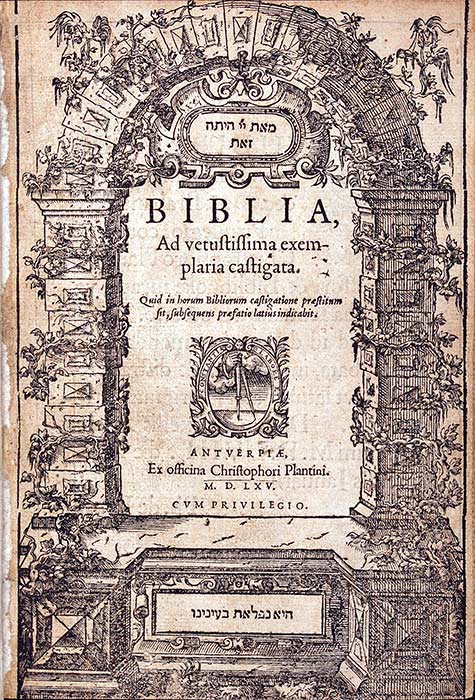Case 14
- The Printer's Device

Biblia, ad ventustissima exemplaria castigate. Antwerp: Ex officina Christophori Plantini, 1565. RBP Bible Latin 1565
The 1462 Latin Bible produced by Johann Fust and Peter Schöffer is an important book for many reasons. It was the fourth printed Latin Bible and the first to be published in two volumes. The printers included their names and the date of completion; becoming the first printed book to do so. Most importantly for the theme of this exhibition, the Fust and Schöffer 1462 Bible was also the first printed book to incorporate a printer’s device, a standard feature of printing by the end of the fifteenth century.
One of the most recognisable printer’s devices is the dolphin and anchor adopted by Aldus Manutius, founder of the Aldine Press in Venice. The device is a reference to the ancient slogan festina lente (‘make haste slowly’). The dolphin, one of nature’s most agile creatures, represents speed, and the anchor, slowness and stability, all essential qualities for a successful printing house.

Biblia, ad ventustissima exemplaria castigate. Antwerp: Ex officina Christophori Plantini, 1565. RBP Bible Latin 1565
Open image in new window
![M. Tullii Ciceronis orationum volumen primum, in quo multa, quæ in aliarum editionem libris corrupte legebantur, ex diligenti uetustorum exemplariu[m] collatione sunt emendate. Venice: Paulo Manuzio, 1540. RPRE 1540 Ita](https://www.reedgallery.co.nz/__data/assets/image/0020/221591/signs-case14-1.jpg)
M. Tullii Ciceronis orationum volumen primum, in quo multa, quæ in aliarum editionem libris corrupte legebantur, ex diligenti uetustorum exemplariu[m] collatione sunt emendate. Venice: Paulo Manuzio, 1540. RPRE 1540 Ita
In 1562, the publisher-printer Christophe Plantin (ca. 1520–89) was accused of heresy after his workmen printed a heretical pamphlet during his absence. Plantin fled to Paris for two years and returned to Amsterdam in 1564. There he set up a press in a new shop at the sign of De Gulden Passer (‘The Golden Compasses’) the printer’s mark of the House of Plantin.
The compass often appeared in a vignette on the title-page of Plantin Press books, such as this 1565 Bible. It is accompanied by the hand of God, using the compass to draw the world, and the motto Constantia Labore et (‘By Labor and Constancy’).
As the publisher of such great works as the eight-volume Polyglot Bible (1572) and Ortelius’s Theatrum orbis terrarum (‘Theatre of the World’), first printed in 1570 and considered the first modern atlas, the combination of the religious and the geographic perfectly symbolize the works of this great Renaissance press.
![M. Tullii Ciceronis orationum volumen primum, in quo multa, quæ in aliarum editionem libris corrupte legebantur, ex diligenti uetustorum exemplariu[m] collatione sunt emendate. Venice: Paulo Manuzio, 1540. RPRE 1540 Ita](https://www.reedgallery.co.nz/__data/assets/image/0020/221591/signs-case14-1.jpg)
M. Tullii Ciceronis orationum volumen primum, in quo multa, quæ in aliarum editionem libris corrupte legebantur, ex diligenti uetustorum exemplariu[m] collatione sunt emendate. Venice: Paulo Manuzio, 1540. RPRE 1540 Ita
Open image in new window


![M. Tullii Ciceronis orationum volumen primum, in quo multa, quæ in aliarum editionem libris corrupte legebantur, ex diligenti uetustorum exemplariu[m] collatione sunt emendate. Venice: Paulo Manuzio, 1540. RPRE 1540 Ita](https://www.reedgallery.co.nz/__data/assets/image/0020/221591/signs-case14-1.jpg)